The Holburne Future Collective release monthly blog posts, including behind the scenes insight, exhibition reviews, comment, and opinion pieces.
We deem it important to have young people’s voices heard in the arts, museums and heritage sector’s.
The Holburne Future Collective release monthly blog posts, including behind the scenes insight, exhibition reviews, comment, and opinion pieces.
We deem it important to have young people’s voices heard in the arts, museums and heritage sector’s.
Hi! I’m Jess, a member of the Holburne Future Collective. In February I was given the opportunity to spend a week away from home at a British Film Institute (BFI) Film & Video workshop where I worked with my team to produce an animated short film. Here’s some of the behind-the-scenes of how the workshop is structured, and how my group in particular used the time we had before and during the residential week. We worked hard throughout two online sessions and one very intense week!
I was very lucky that my college recommended this course to me back in November, a few weeks before the application deadline. As someone who specialises in illustration and is interested in animation, the decision to apply was easy. The application process was relatively simple; only a few personal information questions and questions about my experience in film. When applying I was nervous that I wouldn’t meet the requirements as someone who’s never animated or done VFX before, but there was no need! The course considers anyone interested as a potential candidate! All that was left was to explain why I should be chosen for the course, and then the option to provide a portfolio (though this isn’t mandatory).
Soon after the deadline, I received an email confirming and congratulating me on my place on the course, along with links to shared folders where I could access information about the online sessions and the residential itself ahead of time. One of the most important things included in this email was the link to the course Discord server. It’s the best place to communicate with others on the course and ask questions to the tutors directly! My advice? Talk to people! I made good friends with other people on the course before the first online session, we had loads of fun and it was obvious we were all very excited to spend time with each other! This server was also just a nice way of bringing together creatives in different specialisms; from cinematographers to writers!
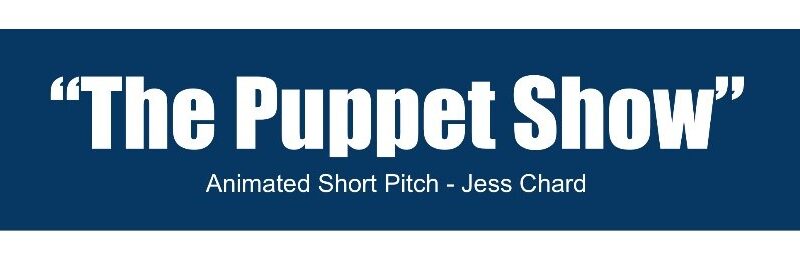
While we were tasked with making friends, we were also tasked with creating a pitch for a short film before the first online session. So, alongside working on socialising, I put together an animated short film pitch, titled “The Puppet Show”. Even as an art and design student, I’d never had to create a pitch before so I was a bit unsure how to make it look visually appealing but still get my idea across.
I joined the live call on January 20th, not sure what to expect, but I received a warm welcome and a brief rundown of how the day was going to work. We were to use the Discord voice channels in our speed pitching groups (organised on the huge information spreadsheet we received right at the beginning of the course), and between 4 people we had to quickly introduce ourselves and our idea before moving channels again. I heard lots of amazing pitches and spoke to my peers using my voice instead of text for the first time! It was a little nerve-wracking! A lot of us felt the same and were a little relieved that we weren’t expected to repeat our ideas to the entire course and instead, our tutors would be doing this step for us. They put a lot of effort into selling your idea- based on any information you could provide to them before the afternoon part of the session. Finally, we had an hour-long Q&A session with an industry speaker, before a short explanation of when voting for the pitches would open and close. Three votes each, for your top three ideas that you want to work on.
In the few days leading up to the voting deadline I refused to look at the document, I didn’t want to know if mine was gaining votes or not. Then, we got our results, and “The Puppet Show” had received enough votes to be produced! I was so glad that people enjoyed my concept!
Online session number 2! Before getting into our groups, we had the chance to participate in some short online workshops for things like online presence, CV advice and portfolio feedback (among others). These were very insightful for the industry however, the best part of the second session was kickstarting the pre-production process. After introducing ourselves and meeting our group’s tutor, we got straight to work on talking through the most efficient way to animate and discussing a shot list. Our tutor provided the idea of rotoscoping; an animation technique where you trace over live footage, I was very eager to do this as it meant we wouldn’t have quite as much freehand animating to do. From there we spent a few hours talking through details such as setting, potential character designs and who would start working on what. At the end of this, we did have a well-established foundation of material to begin preparing, while also having a few other aspects still needing a bit more thought. I rarely work in groups, but coming up with the shot list and seeing everyone’s ideas for the pitch made me excited to work with my team to produce the film. It also immediately developed the idea into something that we all had a part in, rather than it being solely mine.
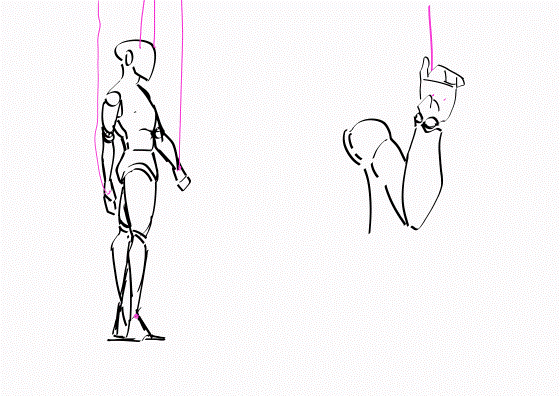
In the weeks leading up to the residential, my team worked on separate parts of the pre-production, which we kept each other updated on as well as asking for feedback. Between the four of us, we split background design, character design, video editing, colour palettes and other odd jobs that needed doing before we got to the residential. My contribution was mostly the character designs and colour palettes, but I did also spend some time working out how strings realistically move a puppet. Putting this research into practice, I animated a very short clip of a “string test”. During the actual character design stage, we made a few changes as a group based on our tutor’s advice. One big change was the removal of the skirt that was originally in the dancer’s design; while it made an interesting silhouette, it would be incredibly difficult to animate in the time we had. Overall, these few weeks were very productive for the group and it made the animation process so much quicker as we had basically everything but the animation done beforehand and could get started straight away.
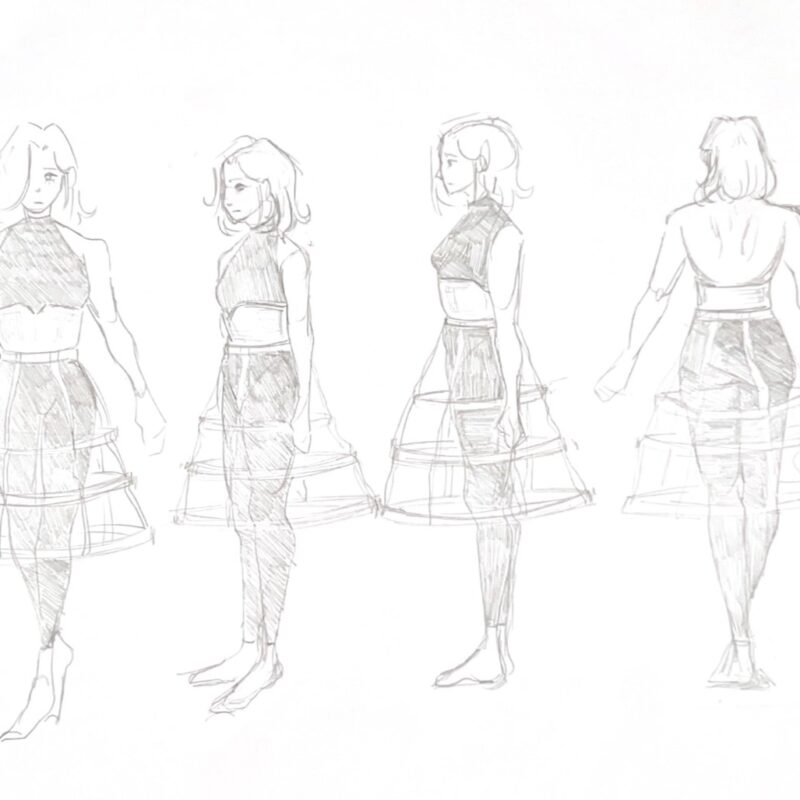
On February 11th I travelled to Cirencester, where the residential would be taking place in the middle of Macaroni Woods (no, we don’t know why it’s called that). Here, I met my team face to face, as well as friends I’d made online. Since some of us were earlier, we took the opportunity to explore the grounds- mostly spending time staring at the animals! Once everyone had arrived lunch was served, before a short introductory talk and then the final task of the first day… setup. Team Puppet Show’s base was in the kitchen of the smaller building, alongside another group under the same tutor. There was a lot of taping wires down (for health and safety!), but we knew if we got it done the first night it meant we had the rest of the time available for production. It was really exciting getting to use the industry-standard equipment! Even though we weren’t expected to start working until the morning, the whole group wanted to try out rotoscoping as soon as we could; this made a huge difference in our efficiency overall as someone in my group managed to completely animate their scene in an hour. I think this gave the rest of us motivation to keep working.
Waking up on the first proper day at the residential was an interesting experience. I remember getting ready and then texting my friends (who were literally in the same building), to see if they were ready as well. Eating breakfast with so many people was also something I’m not used to, but found I quite enjoyed the tired conversations! Every morning we had about an hour and a half for breakfast before a short meeting about how the day would play out, often including a very brief talk about the film industry as well- which gave great insight. For the first two days, we had workshops run by the tutors, each on a different aspect of filmmaking. My first workshop was on the basics of Adobe Animate- I chose this since my team wasn’t using Animate but knew it was a popular programme for animators. The hour went by fast, leading to a lunch break before we started production again. We were quite productive, I alone managed to get roughly 64 frames done which is equal to 8 seconds (working at 8 frames per second). 64 drawings! Other members of my group also got a lot of frames done, providing us with the confidence that we would be able to finish the rotoscoping within the time we had. Once again, we ended up working slightly over what we were expected to work, but we had fun talking and making jokes so it didn’t feel that taxing. After dinner, it was an hour of screenings before free time- most of us spending it with the little groups we’d formed! First day complete!
On day two, it was another workshop opportunity. I chose to do a Photoshop animation workshop this time (run by my tutor!). The programme was new to me and I was keen to expand on what I’d already learned in the past day- the biggest thing was the importance of timing your animation and aligning it with any sound effects. Following on from this, Team Puppet Show had a productive afternoon with two of us finishing our scenes. At this point I had drawn the same two figures dancing so many times I think I could do it with my eyes closed! It was very repetitive, but worth it! Due to some of us finishing shots and others being relatively close, we decided to take a step back and collect everything together in one place to get an idea of what was left to do. Luckily, we weren’t missing too much material, mostly just some faces and a background shot- both doable in the time we had. Using the list we put together, we split the remaining work up again, but also agreed we needed a break. Instead of pushing to finish everything in one night, we opted to spend some time relaxing and playing games with people from other groups and just had a quiet evening all together.
Waking up on day three we had our first full day of production ahead of us! It was a very important day as we were going to be presenting our work in progress (WIP) to the rest of the groups in the evening, meaning we would need some sort of content to show. As I’d finished my wide shots the day before, I was tasked with finishing off a teammate’s shot as they weren’t as confident with consistently drawing the face of the dancer. I worked quickly and managed to get it done within about an hour, freeing me up to draw all of the strings of the puppet; this also only took about an hour or so as it was such a simple detail to add. My final task of the day was to begin animating some curtains that would be at the start, opening to show the performance. The biggest difference here was that I had to fully freehand draw the curtains, rather than rotoscoping over a reference, meaning it took me the whole rest of the afternoon and into the next day to finish! But, finally, after a long day, we could see everyone else’s WIPs. Most people were just under halfway done with their projects at this point and it was exciting to see what had been achieved in the time we’d had so far.
Thursday is what I’d call our last day of production, we had the full day to get the animation finalised before it needed to be composed. As mentioned, my curtain animation ended up taking me the entire morning to get done as I struggled with animating the fabric effectively. Around lunchtime we began exporting all of our animation files, collecting them on the team’s hard drive to both make transferring them easier and have a backup if anything went wrong during editing. Going into the evening, our group made a last-minute decision to fully shade the figures, knowing it would be worth the extra time. The entire team worked well past our expected hours and finally finished shading every frame by close to midnight. We did have a small celebration at this point as we knew that we would be able to finalise everything in time for the deadline.
Friday 16th. The deadline. Getting straight to work on editing, a member of my group worked closely with our tutor to put together all of the different scenes while waiting for some final credit animating to be completed. The sound design and compositing was a long process, and I was anxious that something was missing and we wouldn’t have time to fix it. But, fortunately, we had everything that we needed! At 2pm we handed over the master copy of our animated film and began packing up our equipment. We’d done it!
Following on from all groups handing in their master copies, we took a trip to Oxford where we had an hour to explore before watching a movie. Afterward it was free time back at the site, which I spent with friends and just had a fun night. Since it was the last night a lot of people didn’t want to go to bed, not wanting to leave on Saturday- it was understandable. We’d make good friends, had a great time and made films to be proud of while enjoying the atmosphere. Sadly though, we did have to eventually turn in…
Finally, Saturday morning came around. Everyone had packed the day before so it was a quick breakfast before getting on the coach (with your luggage) and travelling to Swindon. Our films were being screened to an audience consisting of family and friends! It was such an exciting moment, we could see all of our hard work on the big screen! Everyone had done so well, all of the films were amazing! At last, it was time to say goodbye to everyone, it was a bit of a sad moment as we’re all in different parts of the UK. However, I also think a lot of us were happy to see our parents or siblings again, and were looking forward to a weekend of rest after the intense week we’d had.
My final thoughts on this experience are that it helped cement my desire to go into illustration and animation, actively helping me through career advice and first hand experience of what it might be like. It’s helped me plan out the next year or so, giving me options I didn’t even know I had. So, would I recommend it? Absolutely! It was an amazing offer and I’m glad I didn’t just ignore the recommendation from college. I know this was a long read, but I couldn’t find a way of saying how great it was in any less words!
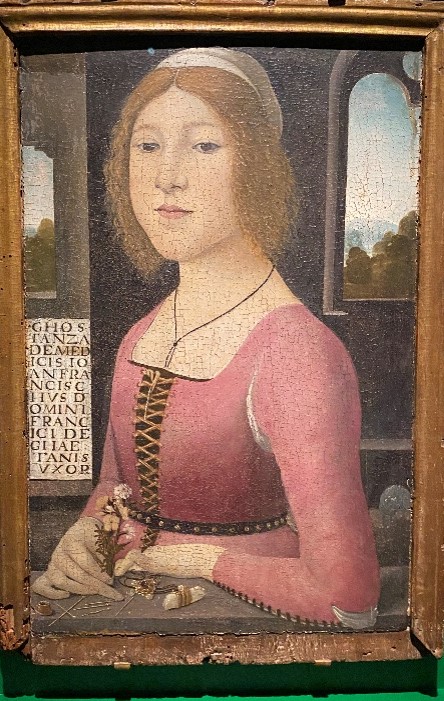 Style of Domenico Ghirlandaio, Costanza Caetani, c. 1480-90, tempera and oil on wood, 57.2 x 37.5 cm, London, National Gallery, NG2490.
Style of Domenico Ghirlandaio, Costanza Caetani, c. 1480-90, tempera and oil on wood, 57.2 x 37.5 cm, London, National Gallery, NG2490.
When I first arrived at the Holburne Museum at the beginning of June 2023, the temporary exhibition Painted Love: Renaissance Marriage Portraits was on display and it totally caught me off guard with the beauty of its pieces. One, in particular, always finds a way to amaze me every time I volunteer in that specific gallery: the portrait of Costanza Caetani’, with its soft colours and small details, is indeed an open window into the period it was painted in and, because of that, has so much to tell.
“GHOS/TANZA / DE MED/ICIS IO/AN FRA/NCISC/HVS D/OMINI / FRANC/ICI DE / GHAE/TANIS /VXOR” can be seen written in humanistic script in the rectangular white label on the left; word for word it reads, “Costanza de’ Medici, wife of Giovanni Francesco di Sir Francesco de’ Caetani”. This particular type of script was first designed by the late-Medieval Italian writer Francesco Petrarca and later redeveloped during the 15th century by the poets and writers who considered the shapes of the Gothic letters to be too difficult to read and remanent of a time that the men of the Renaissance wanted to leave behind. Costanza was indeed born in a time of great changes: with the discovery of the Americas in 1492 and the end of the Middle Ages, European cities started to flourish, and Florence found itself being one of the wealthiest and most important of all in the continent. During these years the Medici family was slowly regaining power over the city after being previously exiled, thus finally consolidating its position in the game of alliances amongst the forces that used to rule the Italian peninsula at the end of the century. The Caetani family, a noble house from Gaeta, in the region of Lazio, was superior to the Medicis in both power and reputation since it was bound to the papal throne since the 12th century. Sure enough, the true name of one of the most famous figures from the Middle Ages, also known as Pope Bonifacio VIII, and famously contributed to the expulsion of Dante from Florence and fought against King Philip the Fair of France’s decision to tax the French clergy, was Benedetto Caetani.
However, we are talking about great conflicts and deeds Costanza would have probably only heard of and never experienced herself, not just because she lived two centuries later than Bonifacio and Philip but mostly because, during her life, she was forced into a simpler position as the wife of Giovanni Francesco. The painting itself speaks about her situation through all the symbols here depicted: the sprig of orange blossom she holds in her hands and the ruby necklace finished off with the three pearls, both of which are metaphors of chastity and purity, to the dog painted down on the right, which symbolizes fidelity, Costanza was meant to be the pure and loyal wife In addition to her gown painted with magenta tempera – nothing but a specific shade of purple, the colour that has been associated with nobility and aristocracy since the Medieval times and the one the Medici family adopted during the Renaissance to represent its house – she wears a veil on her head, which, with the three rings on the bolster, the pins and the needle on the table she leans on, is an expression of her new life as a married woman. The idea that veils are only found in the wardrobes of Islamic women or occasionaly on a bride is in fact completely deceptive: inpast centuries Christian women were forced to wear veils and caps ever since Saint Paul wrote in his first epistle to the Corinthians “For if the woman be not covered, let her also be shorn: but if it be a shame for a woman to be shorn or shaven, let her be covered. For a man indeed ought not to cover [his] head, for as much as he is the image and glory of God: but the woman is the glory of the man. For the man is not of the woman; but the woman of the man.”[1].
Even though the life of a married woman must have been everything but easy, Costanza looks at the visitors with kind eyes and a calm expression, only slightly facing viewers as if she had been busy doing something else before finally gifting the spectators a glance. I seriously think that she and I could stare at each other for hours; me just wondering what her whole story must have been, beyond the mere meanings of the objects she was portrayed with, and her just waiting in vain and in silence for me to fully understand it.
[1] Saint Paul, Holy Bible, First Epistle to the Corinthians (11, 6-8)
By Frederica Burato: Holburne Future Collective Member
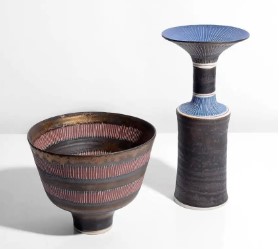
Lucie Rie was an Austrian-British artist who is renowned as one of the most important ceramic artists of the twentieth century. She is remembered for her innovative approaches to glazing and firing and her clean, modernist forms.
Rie was born in Vienna in 1902 to secular Jewish parents. She knew from an early age that she wanted to be an artist, and immediately gravitated towards pottery after seeing a pottery wheel for the first time. In 1922 she began studying pottery at a school of arts and crafts in Vienna. In 1925 she established her own studio in Vienna and continued working there for the next twelve years.
In 1939 she fled Nazi Austria, emigrating to London where she established a home and studio at 18 Albion Mews near Hyde Park. After arriving in London, Rie supported herself by producing glass and ceramic buttons under Franz Lampl who was also an Austrian refugee. Rie’s years of button making allowed for experimentation and collaboration which greatly impacted her later work. She created her own moulds which she would press clay into to produce buttons and also made thrown buttons on a wheel. During this time, Rie also began experimenting with mixing her own unique glazes.
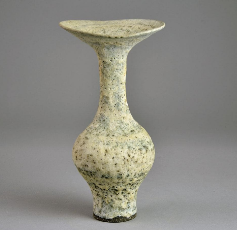 Rie experimented with combinations of ingredients to produce glazes with textured and pitted finishes, and especially loved glazes that bubbled at the surface when fired. She referred to these highly textured, bubbling glazes as her ‘volcanic’ glazes. She also chose to use a very unusual single-fire glazing process in which glaze would be applied to raw clay rather than the traditional application of glaze after an initial bisque firing. She initially chose to fire her work this way out of convenience as she had to transport her pots across the city by tram to be fired, but she continued to use this process long after acquiring her own kiln.
Rie experimented with combinations of ingredients to produce glazes with textured and pitted finishes, and especially loved glazes that bubbled at the surface when fired. She referred to these highly textured, bubbling glazes as her ‘volcanic’ glazes. She also chose to use a very unusual single-fire glazing process in which glaze would be applied to raw clay rather than the traditional application of glaze after an initial bisque firing. She initially chose to fire her work this way out of convenience as she had to transport her pots across the city by tram to be fired, but she continued to use this process long after acquiring her own kiln.
In addition to her experimental glazing work, Rie is also known for her surface techniques. On many of her works, she used a sgraffito technique, coating her pieces in coloured slip and scratching it away to reveal the original clay colour beneath, creating linear patterns or crosshatching. She also experimented with combining different coloured clays into a single piece and used a technique called ‘flashing’ in which she would apply powdered clay to the outside of a pot before firing to create subtle variations in colour.
In the late 1940s, Rie switched from using earthenware clay, known for its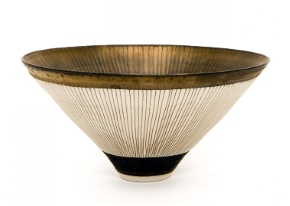 durability, to stoneware and porcelain which could be thrown thinner, creating lighter more delicate pieces. Many of the bottles and vases that Rie made during this period feature thin, undulating rims, drawing the viewers’ attention to the spinning motion of the pottery wheel on which the works were made.
durability, to stoneware and porcelain which could be thrown thinner, creating lighter more delicate pieces. Many of the bottles and vases that Rie made during this period feature thin, undulating rims, drawing the viewers’ attention to the spinning motion of the pottery wheel on which the works were made.
Rie’s clean, modern forms show the influence of the modern artists and architects that she crossed paths with when she was still working in Vienna, as well as movements such as Jugenstil and Japonism. This preference for clean, architectural forms contrasts with the work of her contemporary Bernard Leach with whom her work is often compared. Leech advocated for highly organic forms which contrast with Rie’s refined and minimalist forms. Her preference for these refined forms sets her apart from the predominant movement in British ceramics at the time.
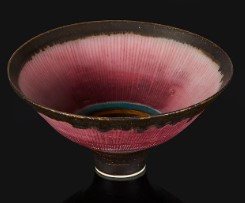 However, as can be seen in her experimental glazing, Rie did not seek a look of pure refinement in her pots. Her work shows a synthesis between these two contrasting approaches to pottery: that of fine, uniform pieces with clean lines and the expressive, organic work of artists such as Leach. One of my favourite of her pieces is her pink bowl (pictured) which is an exquisite example of the way she combined expressive, experimental techniques with great refinement of form. It features a great variety of glazes and techniques which are unified and elevated by the thin, precise shape of the thin-walled vessel.
However, as can be seen in her experimental glazing, Rie did not seek a look of pure refinement in her pots. Her work shows a synthesis between these two contrasting approaches to pottery: that of fine, uniform pieces with clean lines and the expressive, organic work of artists such as Leach. One of my favourite of her pieces is her pink bowl (pictured) which is an exquisite example of the way she combined expressive, experimental techniques with great refinement of form. It features a great variety of glazes and techniques which are unified and elevated by the thin, precise shape of the thin-walled vessel.
Rie’s legacy continues on in the work of ceramicists today who are inspired and informed by her experimental approaches to materiality, firing, and glazing as well as her clean, modernist forms. Her work inspired a generation of potters and continues to be recognized for its remarkable quality today.
Marriage today is seen as something that is meant to be based on love, happiness and a connection between two people but in the early modern period politics and the national interest was more important than affection or love. Marriage was a transaction between two countries or dynasties. This can be seen specifically as a diplomatic exchange to bring two powers closer
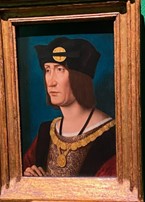
together and create an alliance or resolve a dispute. Many young members of the nobility or royalty were married off at young ages to people they had never met. The only way in which they knew what their future spouse looked like was through portraits made specifically to depict the sitter in their best light. The painting of King Louis XII of France is believed to
have been taken by envoys to the English Court of Henry VIII to show off his worthiness as a possible spouse to Henry VIII’s sister Mary Tudor. This was aimed to show off himself
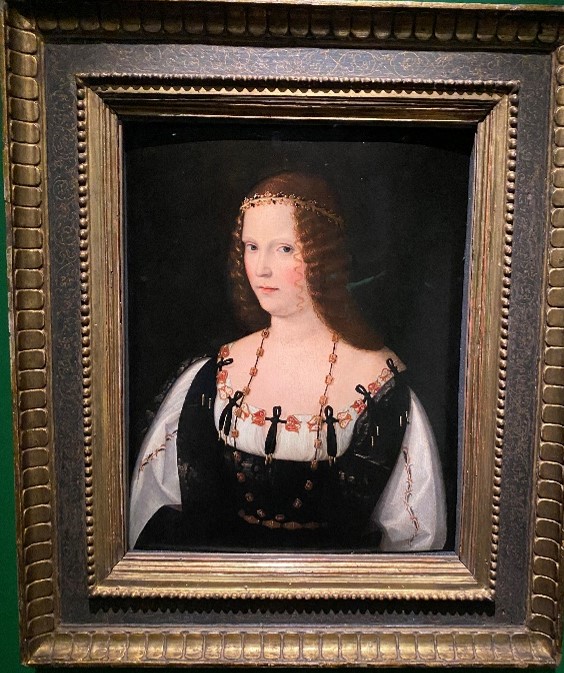 to his future bride and the court. She was eventually married to him via proxy, without Louis even being present and was used as pawn in an alliance between France and England.
to his future bride and the court. She was eventually married to him via proxy, without Louis even being present and was used as pawn in an alliance between France and England.
Marriage portraits were used specifically to show off the qualities of the spouses. Women were depicted as having ageless beauty, an ideal quality for women, and were often holding flowers to represent chastity, love, piety and virtue. Both the painting Constanza Caetani and the Painting of a Young Lady depict these ideal qualities of a woman. Constanza is depicted holding a sprig of orange blossom representing the virtue of chastity. The Young Lady is seen with a necklace around her neck which is a set of rosary beads which is used to symbolise her piety and religious belief. Both women also have fair skin to depict their feminine beauty. Alongside beauty, the virtues of chastity and piety were important to be seen within a woman so they could be seen as an eligible and worthy bride for a noble suitor.

Upon marriage, the two people, if nobility, would have gained new social roles and the symbolism of this is also became reflected in their marriage paintings. This includes the painting of Lorenz Kraffter and his wife Honesta Merz. Lorenz is shown with the castle and the church in the background being his domain because of the politics and being in charge of the land whilst Honesta is dressed in a more domestic style because she was in charge of the household, focussed on family and raising children. This painting does not depict real love but a unity and alliance created for what was best for the political situation.
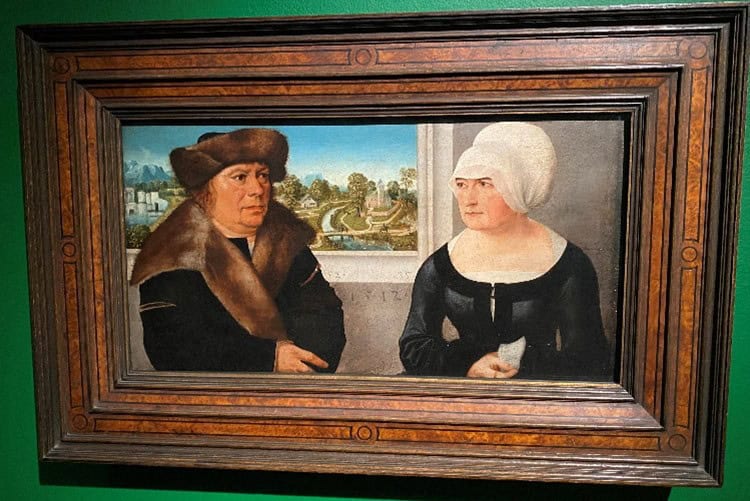
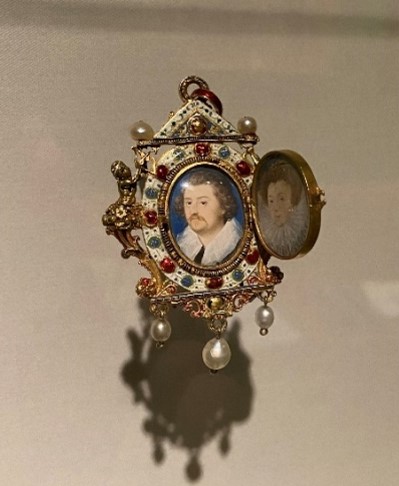
Even though the majority of these paintings were created for a specific political purpose, miniatures were created and designed to show a sense of real love and affection. These paintings were designed to be small, hidden and worn near the heart to prove real love for the person that was depicted with the miniature. The Gresley Jewel, a rare example of a double miniature together proves and shows the real love that must have existed between the couple. Furthermore, after the death of Mary’s husband Louis XII she was finally able to marry the man she truly loved, Charles Brandon, in defiance of the usual political or diplomatic transaction that would occur with a marriage of her status. The painting of Mary Tudor and Charles Brandon (Click here to view ) shows them very close together, holding hands and depicts a real sense of love that existed between the two. The artichoke and caduceus is used to symbolism the love and betrothal between the couple. Even though the majority of marriages that took place between royals and within the nobility was not because of love there were still some key examples of where real love won out against the established diplomatic and political nature of marriage and love.
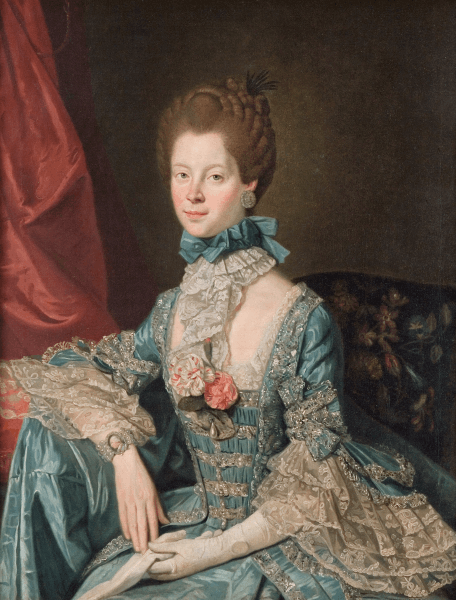
When wandering through the gallery during my volunteering hours, this portrait of Queen Charlotte always catches my eye. Perhaps it is the assured eye contact that Queen Charlotte commands or the elegant details of her flowing dress, but I am always captivated.
This painting is my favourite piece from the collection because of the elegant and detailed way the dress, with its lace and floral details, are painted. I also love the painting for its contrasting colour pallet of bright blues and muted reds. These details are what drew me to the painting before I knew the interesting story of the sitter. Once I had researched a little about Queen Charlotte and her story it became a firm favourite.
This painting is a framed oil painting of Queen Charlotte from the studio of Johan Zoffany from around 1766. Sophia Charlotte was Queen of Great Britain and Ireland as the wife of King George III from 1761 until her death in 1818. When this portrait was painted, she was in her early twenties and already the mother of four children, going on to have fifteen children in total. This portrait was painted by Johan Zoffany, a German neoclassical painter. Zoffany held the patronage of Queen Charlotte, who was a keen patron of the arts. Neoclassicism drew inspiration from the art and culture of antiquity after the discovery of Roman ruins in Pompeii and the publication of an influential history of ancient art in 1764 by German scholar Winckelmann.
Specifically, neoclassical painting revived an interest in symmetry and simplicity. While Queen Charlotte’s dress is anything but simple, the muted background contrasts to the blue elegance of the dress. The simple composition of the portrait, with Charlotte centrally placed, also adheres to this style of neoclassical painting. The precise definition of Charlotte’s dress and the delicate rendering of her features and hands is also a feature of neoclassical painting. Charlotte is dressed in silk, silver and lace and her hair is dressed in the French style of the time, elegantly bound. One of her gloves is removed to reveal a miniature portrait of her husband. Portrait miniatures were often given as tokens of love and sometimes exchanged during marriage negotiations. By the 18th century miniatures were often worn as jewellery, as seen here with the portrait set into a delicate pearl bracelet. Portrait miniatures were also worn as necklaces or rings. This show of intimacy and love towards her husband is a purposeful declaration with the decision to reveal it with the removal of the glove. This portrays Charlotte as a woman of elegance, taste and a devoted wife and Queen.
This taste extends to the Queen’s love of music. Queen Charlotte and her husband were connoisseurs of music, loving the work of composers such as Handel and Mozart. Mozart’s Opus 3 was dedicated to the Queen when it was published in 1765. The Queen was also an amateur botanist and founder of Kew Gardens.
With the recent releasing of Queen Charlotte: A Bridgerton Story on Netflix on the 4th May, famously filmed at the Holburne, the discussion of whether Queen Charlotte was the first black Queen is of even more interest. In an article for The Guardian, Stuart Jeffries discusses different historical opinions on the subject. Historian Mario de Valdes y Cocom argues that her features were conspicuously African, and further claims that she was directly descended from a black branch of the Portuguese Royal Family. Many historians are sceptical about this theory, however, arguing that the “generational distance between Charlotte and her presumed Africa forbear is so great as to make the suggestion ridiculous.” Nevertheless, the new series of Bridgerton centres on the story of Queen Charlotte who is based on the real-life wife of King George III and played by Golda Rosheuvel. The young Queen Charlotte is played by India Ria Amarteifio. As Meilan Solly writes the show “takes substantial liberties with the historical record, portraying Charlotte as a black woman whose marriage opened doors for people of colour in 18th-century England.” Bridgerton is a Shondaland production, headed by Shonda Rhimes. Shondaland’s shows frequently centre strong but complex black female characters including Bridgerton, How to Get Away with Murder and Scandal. Queen Charlotte: A Bridgerton Story chronicles how the young queen ascended the throne and married King George III. Showrunner Chris Van Dusen explains that the “show is for a modern audience, featuring modern themes and characters, so we took liberties in our re-imagining. Our take on race in the series is an example of how we mixed history within a fictional world.”
The life of Queen Charlotte, the debates about her black ancestry and her connection with her husband through the arts and nature are deeply fascinating. Her captivating look within this portrait invites the viewer to speculate about her life, interests, and story. While we will never truly know her ancestry or feelings, this portrait affords us a glimpse into her position as a curious, artistic, and loving mother, wife, and Queen.
Sources: Eleanor Bley Griffiths, “Who was Queen Charlotte and was she Black, as seen in the Bridgerton spin-off?” Radio Times, 6th May 2023 https://www.radiotimes.com/tv/drama/Bridgerton-queen-charlotte-black-real-life-netflix/ “Framed oil painting: Queen Charlotte (1744-1818),” Holburne http://collections.holburne.org/object-a359 https://www.royal.uk/queen-charlotte Meilan Solly, “The Real History Behind ‘Queen Charlotte: A Bridgerton Story,’” Smithsonian Magazine, 5th May 2023 https://www.smithsonianmag.com/smart-news/the-real-history-behind-queen-charlotte-a-Bridgerton-story-180982130/ Stuart Jeffries, “Was this Britain’s first black queen?” The Guardian, 12th March 2009 https://www.theguardian.com/world/2009/mar/12/race-monarchy
Once an art exhibition has been installed in the museum, before its doors are opened to the public, the countdown to its deinstall process begins. But what exactly takes place during the systematic deinstallation of an exhibition? This article will take you behind the scenes of the exhibition deinstall of ‘Elisabeth Frink: Strength & Sensuality’ from start to finish.
On Friday the 9th of January, in the closed and seemingly quiet museum, work had begun preparing the galleries for an exhibition rotation. The first step in reverting the gallery back to a blank canvas involved removing the information labels, placed next to each work, which included context about each artwork. The careful and meticulous removal of the eleven wall-mounted artworks then followed. To conserve the artworks’ condition, the framed works on paper were placed on foam bricks whilst awaiting their subsequent transfer down into the Holburne’s storage facility. Blu-tack-stained dots and screw holes on the gallery walls were now the only trace of the dismantled exhibition, soon to be covered up by a new coat of paint and new artworks.
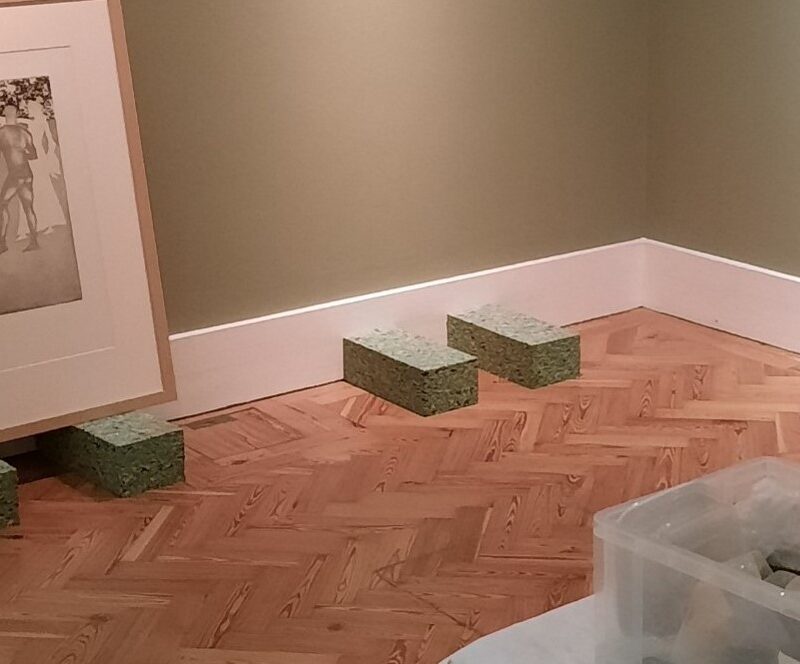 Deinstallation process of ‘Elizabeth Frink: Strength & Sensuality’. The Wirth Gallery. Holburne Museum. Emma Matthews 2023
Deinstallation process of ‘Elizabeth Frink: Strength & Sensuality’. The Wirth Gallery. Holburne Museum. Emma Matthews 2023Following Frink’s works on paper, her bronze sculptures, which were displayed on the exterior wall of the gallery, were removed along with the plinths which encased them. During this handling process, the sculptures were held with gloves to protect the bronze from any damage. The gloves also served as a barrier protecting the handlers from any irritation that the sculptures’ materials or surface could cause. Ensuring the sculptures’ condition would be preserved for any future viewings or exhibitions, they were placed into storage boxes with tissue paper for padding to be stowed.
Down in the stores, the frames enclosing Frink’s works on paper were delicately opened one by one, with each one revealing a print inside. Unlike with the sculptures, the works on paper were handled gently with clean hands as fibres from cotton gloves could catch easily on the fibres of the paper, potentially causing a tear on the surface of the artwork. Once they had been removed from the frame, the works were carefully returned to their permanent location in the stores. To protect the works on paper inside the folder, each artwork was layered in between large pieces of tissue paper to preserve and protect the objects. Once all the framed works had been unframed, assessed, and stored the bespoke frames were packaged with bubble wrap to be exported to an external storage facility.
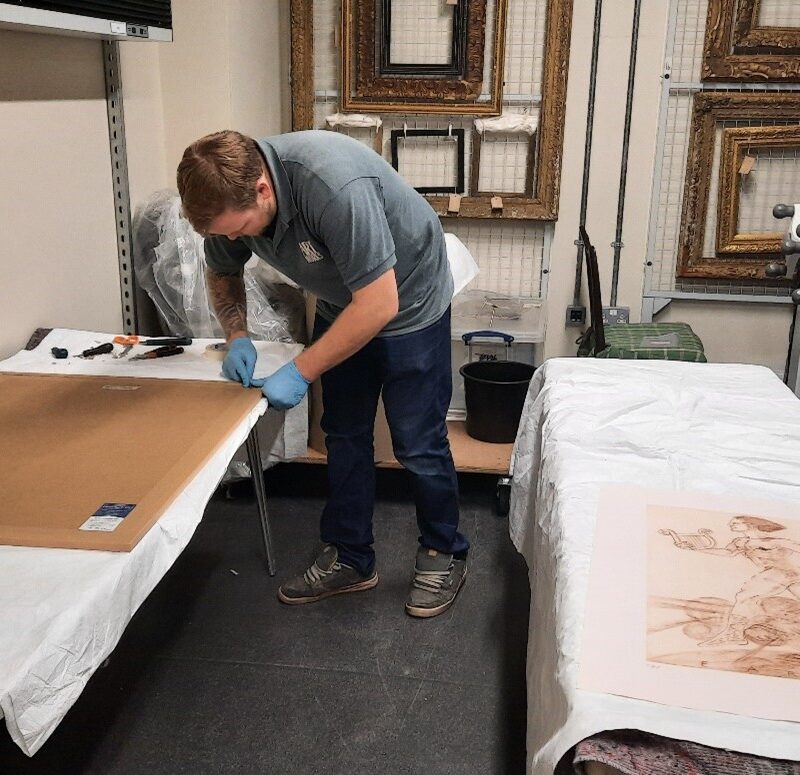 Deinstallation process of ‘Elizabeth Frink: Strength & Sensuality’. Holburne Museum. Emma Matthews 2023
Deinstallation process of ‘Elizabeth Frink: Strength & Sensuality’. Holburne Museum. Emma Matthews 2023Following and documenting the deinstallation reveals how complex and meticulous this journey from the gallery to the store really is. The success of the process depends on the ability of the curators, handlers, technicians, and experts being able to work simultaneously alongside each other to ensure the artworks remain in their perfect condition throughout. However, once the deinstall is complete and the store doors are closed shut, there is no time to waste as the work to install a new exhibition begins… consequently starting the countdown to a deinstallation process all over again.
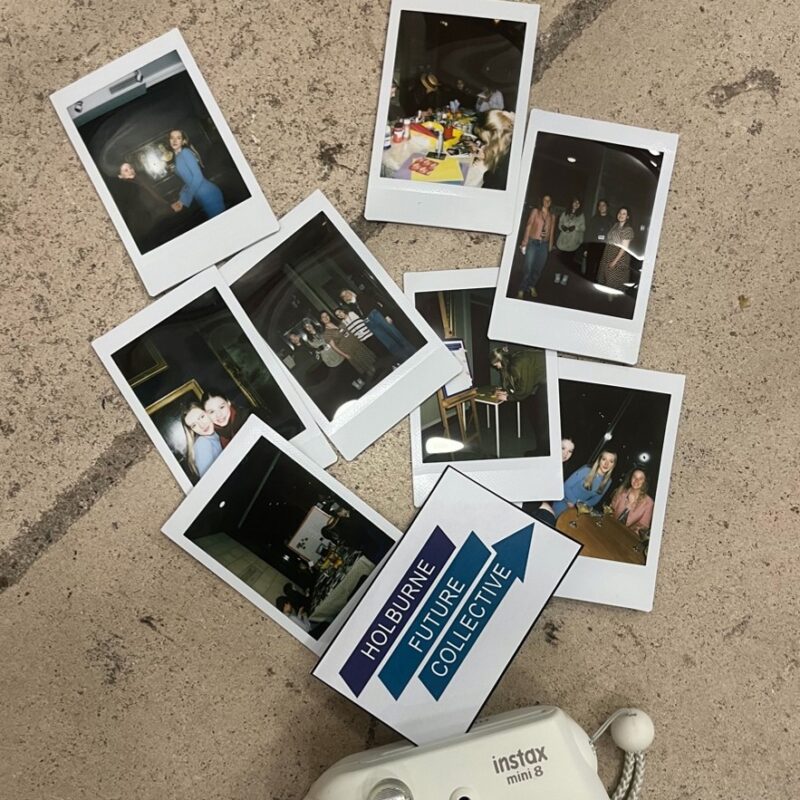
We all have busy lives with work, uni, and adulting in general, so it might be hard to find time to do the things we actually want to. The Holburne Museum, works with a young person’s busy schedule with free monthly after-hours events, called Up Late.
Up Late is a project sponsored by The Holburne Museum that’s hosted by various organisations with an interest in the arts. Up Late showcases the museum’s relationship with the new generation and celebrates their involvement in the arts. Guests are invited to explore the permanent collections for free, receive discounted entry into temporary exhibits, such as Alberta Whittle’s Dipping Below A Waxing Moon, The Dance Claims Us For Release, and enjoy music and drinks in the Garden café and Terrace.
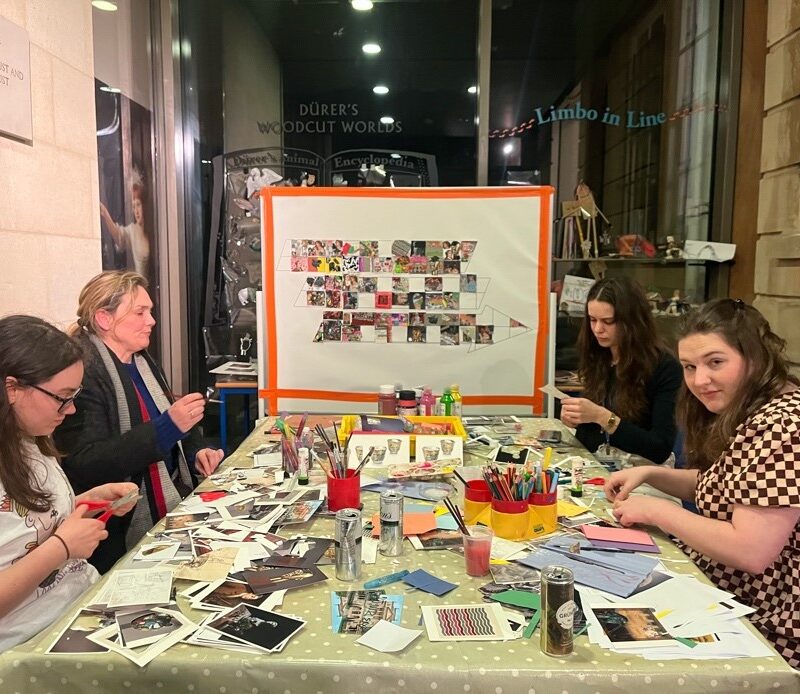 Young people from different organisations such as Holburne Future Collective, Make it New, Bath Spa University and University of Bath.
Young people from different organisations such as Holburne Future Collective, Make it New, Bath Spa University and University of Bath.
Up Lates run on the last Friday of the month all year round apart from December.
The next Up Late will be hosted by Bath Spa University Textile Design for Fashion and Interior on March 31 at 5:00 pm – 9:00 pm. Check the Holburne website to see all upcoming Up Lates.
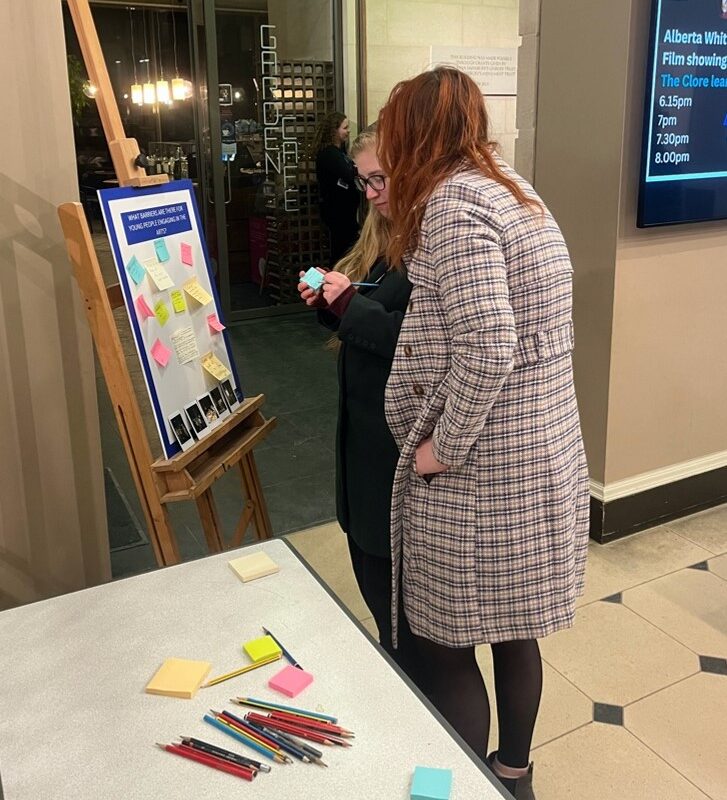
We are a group of young people between 15 and 25. Members can gain a wealth of experience to help with confidence, enhance their CVs and gain work experience essential to securing work in the museum and heritage sector. The Holburne Future Collective meet once a month and write blog posts for our website as well as creating social media content. Most recently, members of the collective had the opportunity to conduct, film, and edit a video interview with Alberta Whittle about her exhibition at the museum.
We launched the Future Collective through running an Up Late at the end of February and it was a roaring success.
Our guests had access to the café, multiple viewings of our exclusive interview with artist, Alberta Whittle, and a craft station where they could make a collage and put it on display. By the end of the night, collectively, our guests made a beautiful piece of art in the shape of the Future Collective logo! During the event, we had our Future Collective members taking and handing out free polaroid pictures to anyone who wanted one! Throughout the museum, we also had three questions that the guests were encouraged to answer.
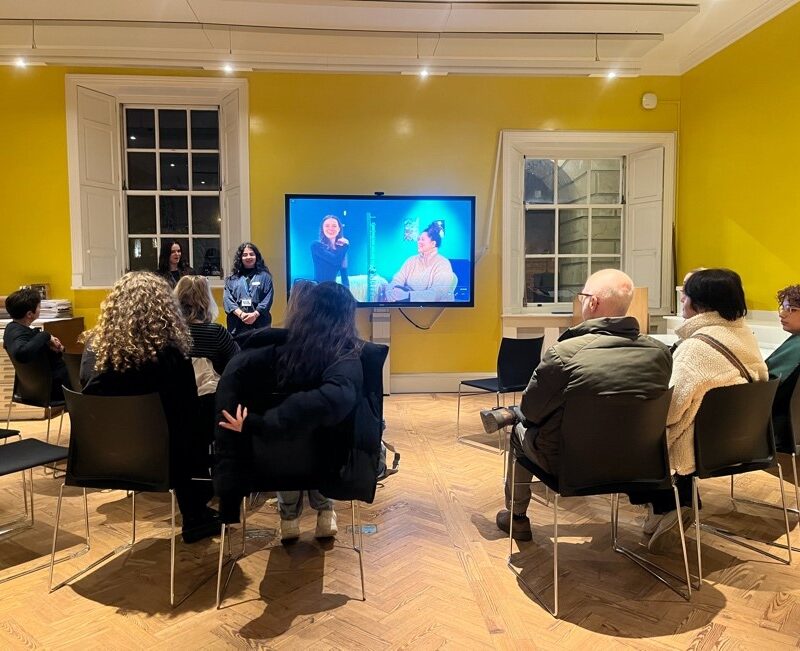 When guests entered the lobby of the museum, they were greeted by the question: “What barriers are there for young people in the arts?”. To create an open dialogue, we invited our guests to write their answers on sticky notes and place them on the question board. We really wanted to get everyone thinking about the relationship between museums, art and the involvement future generations. Most people responded to our first question saying that art preserves our culture and allows us to express our individuality.
When guests entered the lobby of the museum, they were greeted by the question: “What barriers are there for young people in the arts?”. To create an open dialogue, we invited our guests to write their answers on sticky notes and place them on the question board. We really wanted to get everyone thinking about the relationship between museums, art and the involvement future generations. Most people responded to our first question saying that art preserves our culture and allows us to express our individuality.
On the first floor, museum goers were faced with another question: “How and why should the next generation get involved in the arts?”. Once again, we received many wonderful answers with several people seeming to agree that the future of art is dependent on the actions of the younger population.
On the top floor, we posed one last question to our guests: “What does the future of museums look like to you?”. It was arguably the hardest question to answer, but our guests blew me away with some of their fantastic replies! My favourite answer was that museums will be more collaborative with the broader community and truthful with their collections’ origins. Truly, I couldn’t hope for a better future than one where museums thrive on inclusivity and honesty.
Our goal in asking these questions was simple: we want young people to feel like they can get involved in the art world without fear of judgement or pressure! As proven by several of the answers we received throughout the night, it’s clear that us young people don’t always feel like we’re free to engage in the arts. Reasons why include unclear funding, being told there’s a lack of jobs in the art and museum sector, we don’t have enough experience, or the stigma that is associated with learning Art History.
 As a member of the Future Collective, I find myself facing the same problems that our guests voiced when trying to become involved in art and museum sectors. However, organisations such as the Future Collective help with getting a foot in the door and providing the experience I need for a future career in the arts. To me, if more museums take the step to reach out to young people, like the Holburne is doing, then I think the future for young people in the arts will be bright.
As a member of the Future Collective, I find myself facing the same problems that our guests voiced when trying to become involved in art and museum sectors. However, organisations such as the Future Collective help with getting a foot in the door and providing the experience I need for a future career in the arts. To me, if more museums take the step to reach out to young people, like the Holburne is doing, then I think the future for young people in the arts will be bright.